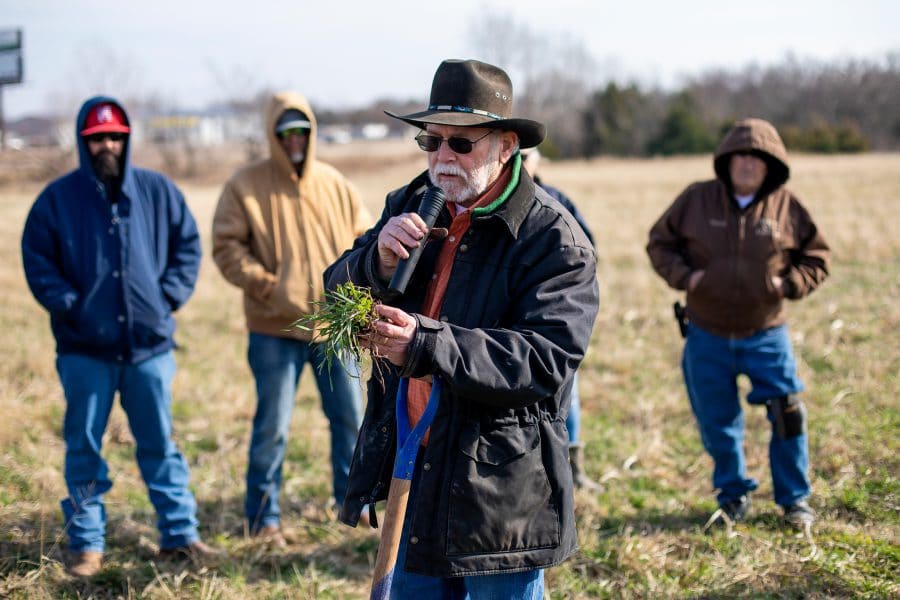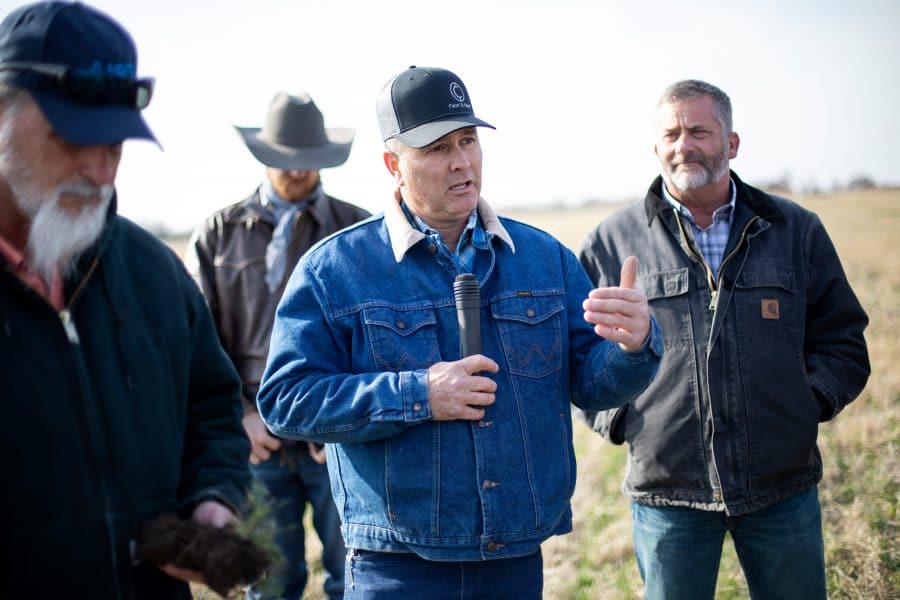Just like a building needs a strong, stable foundation to last, soil also requires a solid base to grow the plants necessary to feed and clothe the world’s population. Indigenous agriculture techniques have understood this principal since time immemorial, but now modern agriculture is catching up.
“We as Potawatomi people, our traditional beliefs and our teachings — original teachings and original instructions — are as people to take care of all of our relatives. And that’s not just human relatives,” said Citizen Potawatomi Nation Community Garden Assistant Kaya DeerInWater. “We knew that growing monocultures perpetually was not going to work out long term. Our ancestors knew that, and that’s why we came up with a polyculture, multi-cropping system. We figured that out long, long before corn even got to us in the Great Lakes.”

Employing regenerative agriculture methods improves land quality by encouraging plant and organism diversification while decreasing land disturbance and increasing biodiversity and organic material. Planting cover crops offers producers an opportunity to incorporate those approaches. Because of this, CPN co-hosted a Cool Season Cover Crop Field Day on Dec. 6 at the CPN Cultural Heritage Center to educate farmers from across the region on restorative methods that sequester carbon and rebuild the soil.
“As soon as we went down, saw what could happen, and saw the differences (cover crops) can make in your soil, and all the good that it can do, it immediately became something that CPN was interested in,” said Tonya Kitchens, CPN Real Estate Services Agriculture Program manager. As a CPN tribal member and employee, Kitchens believes in the importance of mindful land management.
“It’s forward-thinking. It is working now for something that our children and great-grandchildren will benefit from,” she explained during the workshop. “If we don’t take care of the future of agriculture, no one else is going to.”
According to the Department of Agriculture’s Natural Resources Conservation Service, five basic principles help maintain and improve soil health. These include ensuring year-round ground coverage and plant growth, no-tillage practices, and diversified production including implementing rotations and sowing cover crops during non-cash crop growing seasons.
“It’s a big focus, especially with the legacy of the Dust Bowl that sadly Oklahoma is still trying to recover from,” DeerInWater explained. During the 1920s and ‘30s, approximately 350 million tons of soil blew away from Kansas, Texas, Oklahoma and other portions of the Great Plains because of agricultural practices like sod busting that removed native plants and root systems. Cover crops serve as an opportunity to reverse the Dust Bowl’s impact across the region.
Tribal land management
The Nation currently has several agricultural endeavors including a community garden, 2,000 acres of land set aside for row crops, 1,100 acres for hay production, 154 acres for sod and 3,200 acres in land leases. Lance Coker of Circle C Farms in Pottawatomie County, leases 132 acres of land from CPN.
“I’ve always been reading about these cover crops, and in the past, I’ve just always done traditional agricultural practices. And I mean, I made money at it, but I knew there was a better way,” Coker said. “I’ve read about this stuff and I thought, ‘Man, I don’t want to use up all my water for my crops.’”
During a hunting trip to southwest Oklahoma, Coker learned about remediation techniques Russ Jackson uses on his family farm. After meeting Jackson, he began looking for ways to utilize the same production methods.
On 45 acres of CPN land near state Highway 177, Coker recently began incorporating no-till practices and in fall 2019, planted a blend of cool-season cover crops including wheat, rye, vetch, Austrian winter peas, alfalfa, and brassicas like daikon radishes and turnips.
As Coker has experienced firsthand, sowing cover crops can result in greater yields. For example, according to Sustainable Agriculture Research & Education Program’s 2017 Cover Crop Survey, corn farmers were able to harvest 2.3 additional bushels per acre.
“On one of my corn crops, I cut my nitrogen back a third and made 20 more bushels an acre than what I did on my conventional till,” Coker said.
Nitrogen, phosphorus and potassium are the “Big Three” primary macronutrients producers use to fertilize. Regenerative agriculture techniques seek opportunities to naturally restore key nutrient levels, decreasing the need to add synthetic chemicals to achieve adequate growing conditions.
“A lot of soil health can be like a car,” said Shawn Fleming, NRCS resource conservationist, during the Dec. 6 workshop. “The main thing is, just don’t keep it parked in the garage.”
The concept is relatively simple: reduce the input. Rather than going to the local co-op or seed store to purchase inorganic nitrogen, regenerative agriculture seeks opportunities to use and increase the overall levels of organic nitrogen. This method also increases the number of living organisms under the earth by creating an environment that is more conducive to their needs.

According to a NRCS fact sheet, “An incredible diversity of bacteria, protozoa, arthropods, nematodes, fungi and earthworms create a hidden food web in the soil that affects how crops grow, how soil nutrients are cycled and whether rainfall is quickly absorbed into the soil and stays where crop roots can access that moisture.”
Since DeerInWater began overseeing Bodewadmi Widoktadwen Gtegan (CPN Community Garden) in 2018, he has incorporated techniques to improve soil quality and influence overall garden health.
“When you use regenerative agricultural practices, the land is more resilient. It’s basically just mimicking nature in a way,” DeerInWater explained. “It’s using principals, but it’s not exactly like nature.”
Like most gardens, Bodewadmi Widoktadwen Gtegan produces during the warm season. To ensure year-round ground cover, staff and volunteers have planted a mixture of cool season cover crops the past two years.
“We wanted to keep live plants in the soil to keep the beneficial soil biota happy and active,” DeerInWater said.
Drought and flood management
Conventional agriculture utilizes tillage, which removes underground root systems and decreases the ground’s ability to absorb water.
“One of the big things that I’ve been trying to do on my farm was maximize rainfall capture,” said Russ Jackson, farmer from Mountain View, Oklahoma, during the Dec. 6 workshop.
“When you’re doing a tillage system like we’ve done for 130 years, it’s always too wet or it’s always too dry,” Jackson said.
Jackson farms in southwest and western Oklahoma, and the region tends to be one of the driest in the state with only an average of 32 inches of rain per year compared to Pottawatomie County’s average of 41. Western Oklahoma’s precipitation often falls in large amounts over a very short period of time, and it is not uncommon to go more than 100 days with less than a quarter inch of rain.
Cover crops and regenerative agriculture techniques keep the root systems intact, loosening the soil, which results in greater water retention. Planting mixtures mimics the natural and diverse plants that once grew.
“You increase the soil health, you increase the water holding capacity, which decreases runoff and erosion. With the water holding capacity, if you ever had a drought, your lands — using those practices — are more able to withstand dry periods for longer because of that healthy soil structure and because of the healthy plant community,” DeerInWater said.
Plant variety ensures the earth has root systems at different levels and offers the microbial organisms living below ground more opportunities to thrive. By incorporating these techniques, the Jacksons increased absorption rate on one plot of land from 6/10 an inch of rain per hour to 2.7 inches. The Nation hopes to have similar results.
“Using those practices that take care of the land and take care of the soil and take care of the animals and the birds and the pollinators is culturally congruent with our teachings,” DeerInWater said. “With all of our success, we are able to have the luxury to rethink about the way that we’re doing things and to regain our cultural practices so that our values as a Nation are aligned with our management practices.”
Learn more about CPN’s garden programming and workshops at potawatomi.org/events.
